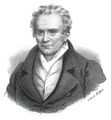Template:Selected anniversaries/August 28: Difference between revisions
No edit summary |
No edit summary |
||
| Line 1: | Line 1: | ||
<gallery> | <gallery> | ||
File:Eclipse.jpg|link=Eclipse (nonfiction)|413 BC: A lunar [[Eclipse (nonfiction)|eclipse]] caused panic among the sailors of the Athens fleet and thus affected the outcome of a battle in the Peloponnesian War. The Athenians were ready to move their forces from Syracuse when the Moon was eclipsed. The soldiers and sailors were frightened by this celestial omen and were reluctant to leave. Their commander, Nicias, consulted the soothsayers and postponed the departure for 27 days. This delay gave an advantage to their enemies, the Syracusans, who then defeated the entire Athenian fleet and army, and killed Nicias. https://en.wikipedia.org/wiki/Sicilian_Expedition | File:Eclipse.jpg|link=Eclipse (nonfiction)|413 BC: A lunar [[Eclipse (nonfiction)|eclipse]] caused panic among the sailors of the Athens fleet and thus affected the outcome of a battle in the Peloponnesian War. The Athenians were ready to move their forces from Syracuse when the Moon was eclipsed. The soldiers and sailors were frightened by this celestial omen and were reluctant to leave. Their commander, Nicias, consulted the soothsayers and postponed the departure for 27 days. This delay gave an advantage to their enemies, the Syracusans, who then defeated the entire Athenian fleet and army, and killed Nicias. https://en.wikipedia.org/wiki/Sicilian_Expedition | ||
||1749: Johann Wolfgang von Goethe born ... writer and statesman. His works include four novels; epic and lyric poetry; prose and verse dramas; memoirs; an autobiography; literary and aesthetic criticism; and treatises on botany, anatomy, and color. In addition, there are numerous literary and scientific fragments, more than 10,000 letters, and nearly 3,000 drawings by him extant. Pic. | |||
||1789: With the first use of his new 1.2 m (3.9 ft) telescope, then the largest in the world, William Herschel discovered a new moon of Saturn, which was later named Enceladus. | ||1789: With the first use of his new 1.2 m (3.9 ft) telescope, then the largest in the world, William Herschel discovered a new moon of Saturn, which was later named Enceladus. | ||
Revision as of 10:26, 26 August 2018
413 BC: A lunar eclipse caused panic among the sailors of the Athens fleet and thus affected the outcome of a battle in the Peloponnesian War. The Athenians were ready to move their forces from Syracuse when the Moon was eclipsed. The soldiers and sailors were frightened by this celestial omen and were reluctant to leave. Their commander, Nicias, consulted the soothsayers and postponed the departure for 27 days. This delay gave an advantage to their enemies, the Syracusans, who then defeated the entire Athenian fleet and army, and killed Nicias. https://en.wikipedia.org/wiki/Sicilian_Expedition
1801: Mathematician and philosopher Antoine Augustin Cournot born. He will introduce the ideas of functions and probability into economic analysis.
1802: Mathematician and engineer Gaspard Monge publishes new class of Gnomon algorithm functions, based on his pioneering work in differential geometry, which detect and prevent crimes against mathematical constants.
- C. Wright Mills.jpg
1916: Sociologist and author C. Wright Mills born. He will be published widely in popular and intellectual journals, advocating public and political engagement over disinterested observation.
1966: New study reveals that the Brainiac Explains lecture series is funded by a Brownian racket.



